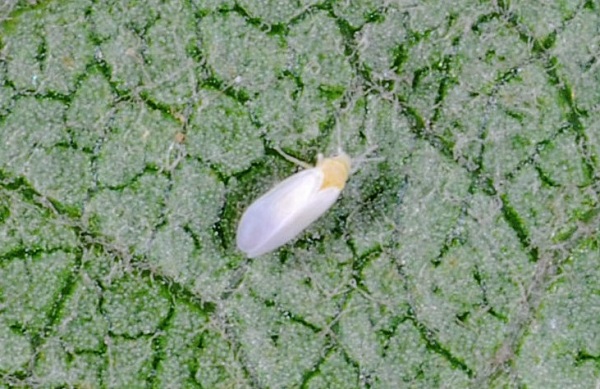Silverleaf Whitefly on Squash
ENTFACT-319: Silverleaf Whitefly on Squash | Download PDF
Ric Bessin, Extension Specialist
University of Kentucky College of Agriculture
Silverleaf whitefly, Bemisia argentifolli, is a relatively new pest to Kentucky. Although they have been a problem for growers in southern regions of the U.S. for several years, outbreaks in Kentucky had been relatively uncommon. Silverleaf whitefly is a common pest of greenhouse plants throughout the year and, in the past, has been a relatively uncommon pest of cultivated plants in the field in Kentucky. Because it is unable to overwinter in Kentucky, it is more likely to be a problem of plants in greenhouses, high tunnels, on transplants shipped from southern regions, or in the field in mid summer and fall. Hot, dry weather during the summer can favor rapid buildup of the silverleaf whitefly on wild and cultivated hosts outside of the greenhouse.
Though the silverleaf whitefly and its close relative, the greenhouse whitefly, are both small (about 1/8th inch) and similar in appearance there are some key differences. Silverleaf Whiteflies tend to have more yellowish body and position their wings closer to the sides of their bodies whereas the more common greenhouse whiteflies are generally paler in color and tend to hold their wings flat on their backs. Typically, the wings of the silverleaf whitefly do not touch such that a small portion of the yellow abdomen is visible between the wings.

Figure 1. Silverleaf whitefly tends to hold its wings close to the sides of its body.
Silverleaf whitefly cannot overwinter in Kentucky because they are unable to survive the freezing temperatures that occur here. However, they can survive in greenhouses and are commonly introduced on transplants produced in warmer regions of the U.S. They have a very wide range of hosts including: tomato, pepper, squash, bean, lettuce, eggplant, broccoli, cabbage, potato, and watermelon.

Figure 2. Silvery appearance to upper surface of infested leaves.
When silverleaf whitefly immature stages feed on squash leaves, their saliva introduces toxins into the plant that can have a dramatic effect on leaves. Developing leaves of affected plants can take on a silvery appearance starting from the leaf veins and moving outward. The leaves on which the immature stages are feeding may not develop symptoms. During heavy outbreaks entire plants can take on a silver appearance in just a few days. The upper epidermis separates from the lower cells causing the white appearance. Affected plants can be stunted resulting in reduced yields and fruit quality.
Management
Unfortunately, small numbers of silverleaf whitefly can cause silvering of small squash transplants. However, once the whiteflies are controlled, the leaves and plants will begin to recover. Damage to younger plants maybe more severe than that to plants closer to harvest.
There are a number of predaceous insects that feed on silverleaf whitefly and one commercial parasitoid wasp, Eretmocerus emericus, that has been used successfully in greenhouses.
Chemical control of whiteflies can be difficult as the adults and immature stage occur on the undersides of leaves, particularly older leaves, making spray coverage difficult. Insecticides listed for whitefly control in https://publications.ca.uky.edu/files/ID36.pdf, can be effective against silverleaf whitefly.
Issued: 11/19
CAUTION! Pesticide recommendations in this publication are registered for use in Kentucky, USA ONLY! The use of some products may not be legal in your state or country. Please check with your local county agent or regulatory official before using any pesticide mentioned in this publication.
Of course, ALWAYS READ AND FOLLOW LABEL DIRECTIONS FOR SAFE USE OF ANY PESTICIDE!
Photos courtesy Ric Bessin, University of Kentucky Entomology
